LABORgLAskAtALOg LABORATORY GLASSWARE CATALOGUE
LABORgLAskAtALOg LABORATORY GLASSWARE CATALOGUE
LABORgLAskAtALOg LABORATORY GLASSWARE CATALOGUE
Erfolgreiche ePaper selbst erstellen
Machen Sie aus Ihren PDF Publikationen ein blätterbares Flipbook mit unserer einzigartigen Google optimierten e-Paper Software.
technIcal InformatIon | product sectIon<br />
technIcal InformatIon | product sectIon<br />
physical properties<br />
temperature resistance when heated and thermal shock resistance<br />
the maximum permissible operating temperature for dUran ® is 500 °c. above a temperature of<br />
525 °c the glass begins to soften and above a temperature of 860 °c it changes to the liquid state.<br />
as it has a very low coefficient of linear expansion (α= 3.3 x 10 –6 k –1 ), a feature of dUran ® is its<br />
high thermal shock resistance up to Δt = 100 k. for a temperature change of 1k, the glass changes<br />
by only 3.3 x 10 –6 relative length units, resulting in low levels of mechanical strain were a thermal<br />
gradient exists. the thermal shock resistance is influenced wall thickness and product geometry.<br />
temperature resistance at low temperatures<br />
dUran ® can be cooled down to the maximum possible negative temperature and is therefore<br />
suitable for use with liquid nitrogen (approx. – 196°c). during such use/ freezing In general dUran ®<br />
products are recommended for use down to – 70 °c.<br />
when working at low temperatures, the effect of any expansion of a dUran ® vessel’s contents<br />
must be borne in mind. during cooling and thawing ensure that the temperature difference does not<br />
exceed 100 k. In practice, therefore, stepwise cooling and heating are recommended. when freezing<br />
substances in such items as dUran ® bottles or dUran ® test tubes, the container should only be<br />
filled to a maximum of 3/4 of its capacity. moreover, it should be frozen slanted at an angle of 45 °<br />
(to enlarge the surface area). the minimum service temperature is dependant upon the properties of<br />
any screw caps or other components used. for the blue PP screw cap the minimum temperature is<br />
– 40 °c.<br />
Use in the microwave<br />
dUran ® laboratory glassware is suitable for use in microwaves. this also applies to plastic coated<br />
dUran ® products .<br />
optical properties<br />
In the spectral range from about 310 to 2200 nm the absorption of dUran ® is negligibly low. It is<br />
clear and colourless. fairly large layer thicknesses (axial view through pipes) appear slightly yellow/<br />
greenish. amber-coloured dUran ® products are suited to use with light-sensitive substances (see<br />
amber colouring of dUran ® ). this results in strong absorption in the short-wave region up to approx.<br />
500 nm. In photochemical processes the light transmission of dUran ® in the ultraviolet range is of<br />
particular importance. the degree of light transmission in the Uv range indicates the ease with which<br />
photochemical reactions can be carried out, for example chlorinations and sulfochlorination. the<br />
chlorine molecule absorbs light in the range from 280 to 400 nm and thus serves as a transmitter<br />
of the radiation energy.<br />
amber colouring of dUran ® laboratory glassware<br />
amber colouring enables storage of light sensitive substances in dUran ® products. light transmission<br />
in the wavelength range between 300 and 500 nm is, in comparison with dUran ® clear glass,<br />
< 10 %. accordingly amber dUran ® glass corresponds to UsP/eP/JP specifications.<br />
to colour an existing piece of dUran ® glassware,it is sprayed using an innovative process with a<br />
special medium-diffusion ink solely on the outside of the clear glass. the piece is heated to a high<br />
temperature which mobilises the diffusing ions into the out layer of glass. on cooling, the ambering<br />
is very uniform, resistant to chemicals and cleaning in a dishwasher. the proven dUran ® properties<br />
within the bottle remain unaffected; there is no contact or interaction between contents and amber<br />
coating. the uniformity of the amber colouring process and the resultant quality of the amber colour<br />
is ensured by continuous monitoring.<br />
overview of the physical properties of technical glasses<br />
description<br />
linear expansion coefficient<br />
α (20 °c/300 °c)<br />
[10 -6 K -1 ]<br />
transformation<br />
temperature<br />
[°c]<br />
density<br />
[g/ cm 3 ]<br />
dUran ® 3.3 525 2.23<br />
fIolaX ® 4.9 565 2.34<br />
soda-lime glass 9.1 525 2.5<br />
sbw 6.5 555 2.45<br />
transmission curves for<br />
dUran ®<br />
conformIty wIth standards and gUIdelInes<br />
alongside the international standard dIn Iso 3585, in which the properties of borosilicate glass 3.3<br />
are defined, dUran ® laboratory glassware corresponds to the current standards for glass laboratory<br />
apparatus. the relevant dIn/Iso standards are given on the product pages of this catalogue. If the<br />
standard is changed, e.g. in case of harmonisation to Iso, our dimensions are adjusted accordingly<br />
within an appropriate time interval.<br />
dUran ® is a neutral glass of high hydrolytic resistance and thus belongs to glass type 1 in accordance<br />
with the european pharmacopeia (eP, chapter 3.2.1), the Japanese pharmacopeia (JP, chapter 7.01)<br />
and the United states pharmacopeia (UsP, section: 660) and national formulary.<br />
206<br />
207



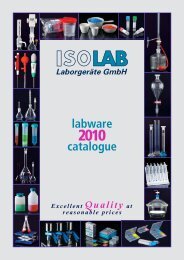
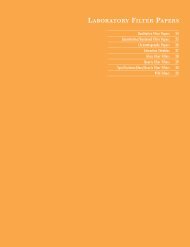
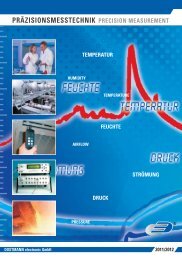
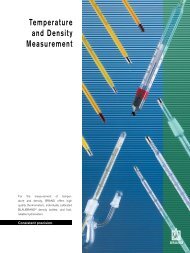
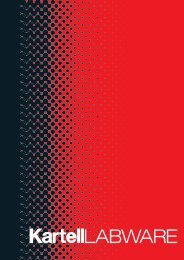

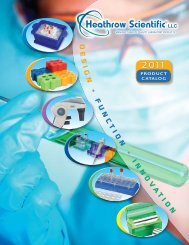


![Download [12.5MB] - Labtek](https://img.yumpu.com/24756492/1/184x260/download-125mb-labtek.jpg?quality=85)
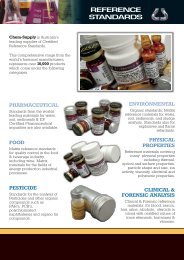
![DYMO Healthcare Brochure [2MB] - Labtek](https://img.yumpu.com/24756484/1/190x240/dymo-healthcare-brochure-2mb-labtek.jpg?quality=85)
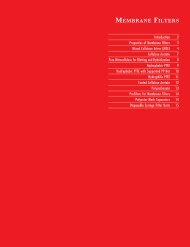
![Download [12.5MB] - Labtek](https://img.yumpu.com/24756470/1/184x260/download-125mb-labtek.jpg?quality=85)